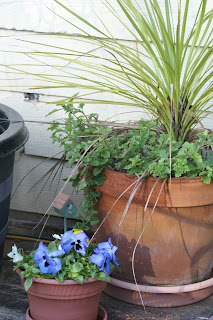The greenhouse plants are still growing. I have had to trim some of the plants back to keep them bushy. I know it is cutting off the blooms, but I will have better-looking plants in the middle of April when I can leave them outside for good.

The 'Homestead Purple' verbena in this clay pot had started to grow and get longer then I wanted. So, I trimmed it up, losing the first flowers, but I know there are more to come!
The Spring bulbs have done wonderfully this year! I fertilized them all last fall and it has payed off. One thing I would like to incorporate next year is planting bulbs in pots with the pansies for a 2-for-1 show. I just have to remember to dig the other plants out in the fall that may still look good. Its a timing thing..
 The Forsythia is in full bloom right now. And my 'layering starts' are hopefully rooting in the buckets. My fountain is starting to need some TLC. So this month I want to seal up the leaks and clean it up so it will be in good shape for the whole growing season.
The Forsythia is in full bloom right now. And my 'layering starts' are hopefully rooting in the buckets. My fountain is starting to need some TLC. So this month I want to seal up the leaks and clean it up so it will be in good shape for the whole growing season. |
| Gerbera Daisies just popping up |
And I have been cleaning and waxing the furniture, and dreaming about future plans, garden brunches, Graduation party, and summer BBQs! What have you been dreaming of?
So, a few activites to accomplish for March:
- repot tomato seedling after 6 leaves appear, pinching off the old 4 leaves
- Start feeding blueberries each month and set out strawberry plants
- divide and take cuttings of Yarrow
- plant Clematis with an inverted pot ( to keep roots cool)
- Do paint touch-up on outdoor furniture and apply car wax for protection.
- till under 'winter crop' or leaves in veggie patch when soil will crumble in your hand
- Plant Lavender, mint and oregano when ground is cool.
- Divide Shasta daisies as shoots appear and fertilize
- Fertilize honeysuckle as new growth appears.
- Prune forsythia and azaleas after flowering
- Shop for roses
- Repot house plants if needed and top dress
- Cut back all hanging basket plants that you wintered over, fertilize and repot if need be
- keep reading and making plans for the days ahead!
 |
| Small vessel surrounded by Iris and Daylilies |












































